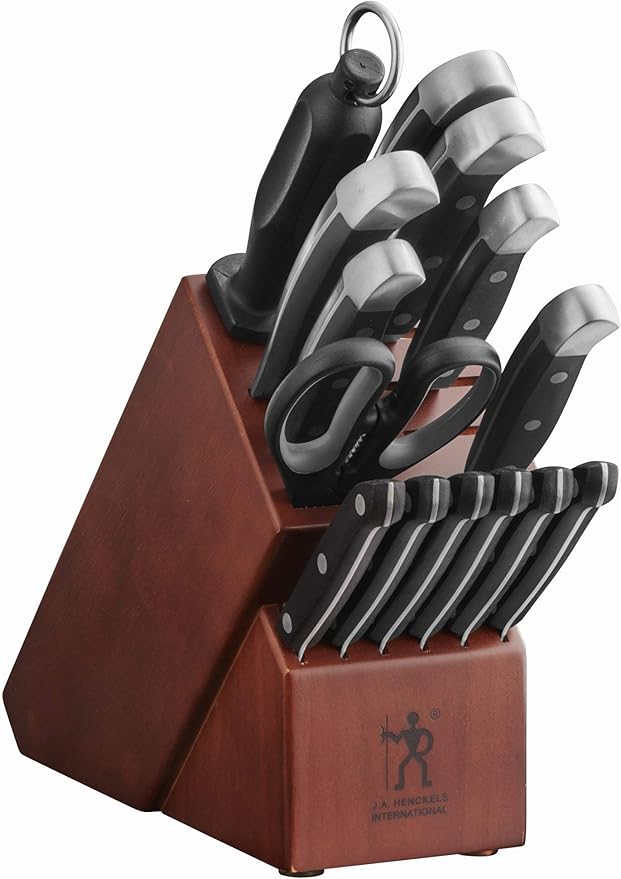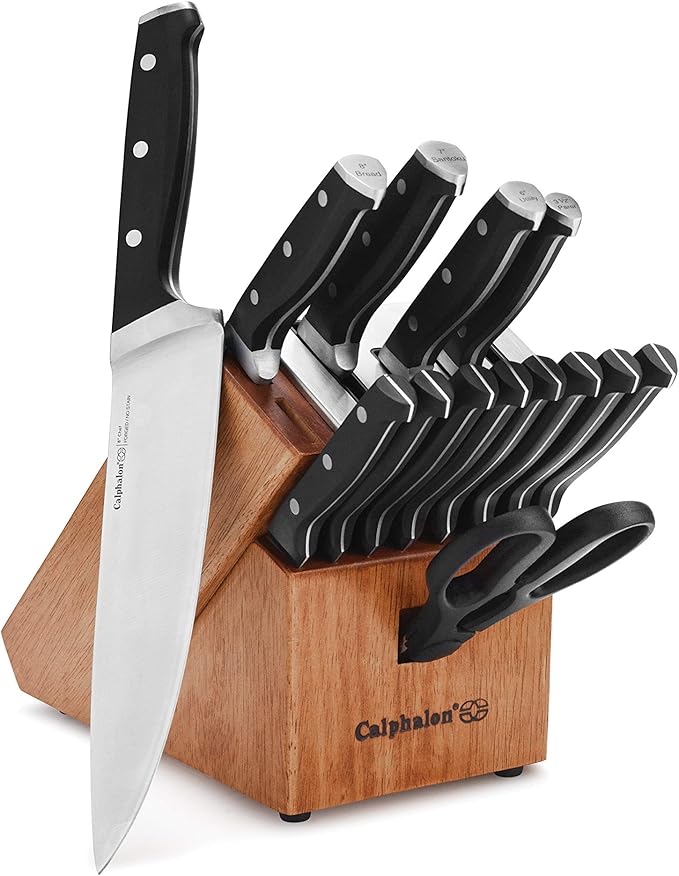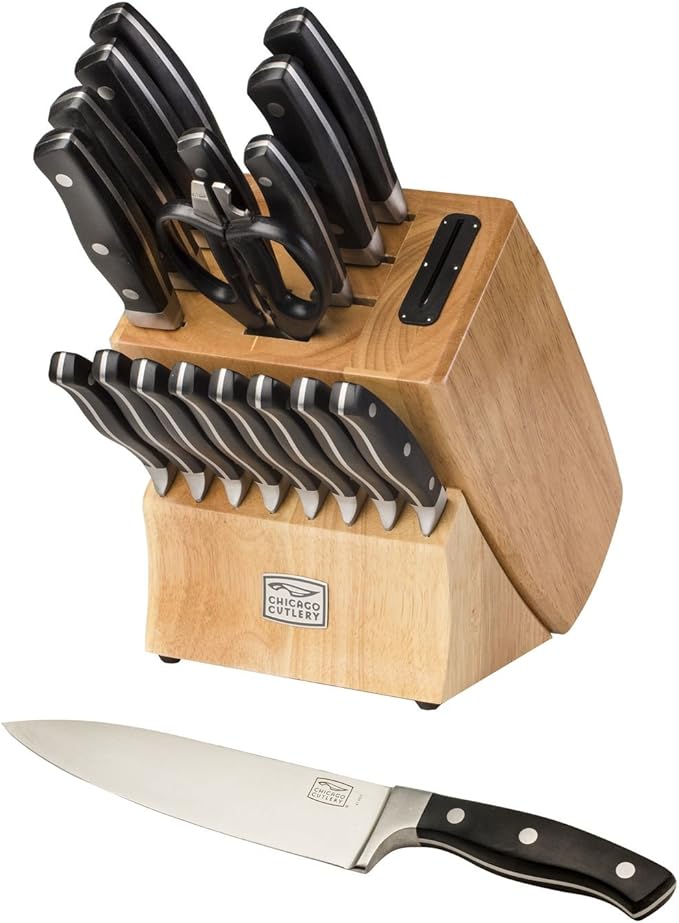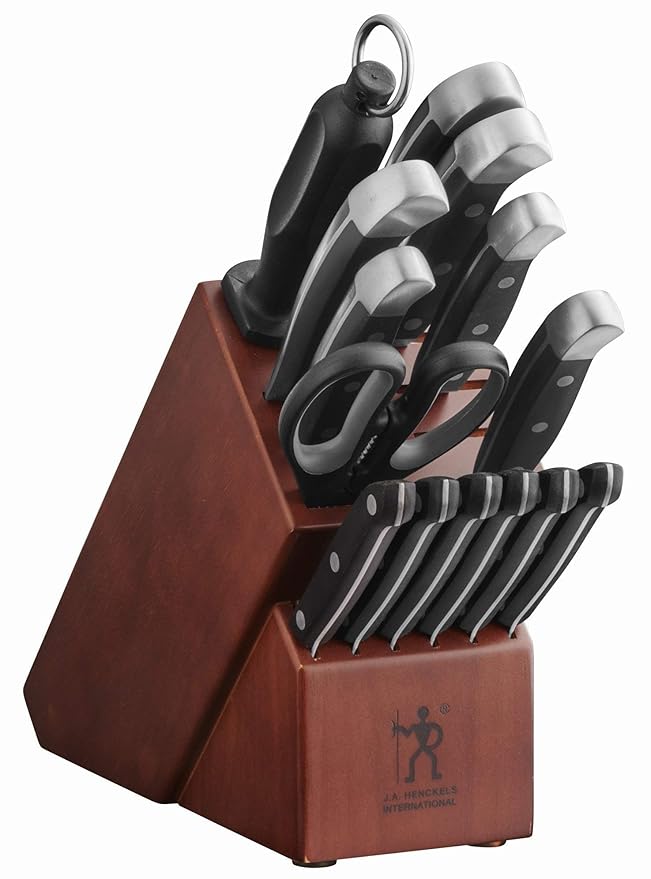Best Kitchen Knife Set For The Money 2023
- Outstanding craftsmanship, cutting-edge technology, stunning design elements, and premium materials. Peak performance has never looked so good at this price.
Last updated on 2022-07-02 at 02:43 / Affiliate links / Images from Amazon Product Advertising API
Well, to begin with, you just can’t have a kitchen that has no knives. Why? Because what’s the use of having a kitchen where you can’t hide out with an incredibly sinister-looking knife, screaming like Shelley Duvall from The Shining, to creep unsuspecting people out?
And you thought that we were going to talk about cutting vegetables?
Well, regarding that, we hope you know that you can’t cut vegetables and meat with the same knife and that a butcher’s knife wouldn’t be of much use if you want to bone your herring with it?
Also, a filleting knife is different from a chopping knife and well, who the heck knew about ceramic blades before this anyway!
In a nutshell, knowing your knives is one of the greatest ways to understand the culinary world better. It is also the most profound method to learn all about the gastronomical science that drives the world of delectable wonders.
So, by now if we have let the chef inside of you down, it’s time we lifted your spirits high up!
In the following extensive guide, we’re bringing you a complete buyer’s guide to kitchen knives.
It will make your culinary experience a dreamy and exciting new avenue for pursuing greater goals and achieving new milestones in cooking!
Table of Contents
Best Kitchen Knife Brands 2023
Model | Number of Knives | Price | |
|---|---|---|---|
1 Chef's Knife | $ | ||
14 Pieces Cutlery Set | $$ | ||
15 Pieces Cutlery Set | $$ | ||
18 Pieces Cutlery Set | $$ |
Dalstrong Gladiator
- Incredibly durable high-carbon German steel construction
- Adheres to the 56+ Rockwell hardness status
- Full-tang blade construction ensures full control and ease of maneuverability
- Can cut through most things including bones and cartilage
- Resistant to rust and stains
- Backed with a full refund policy
Cons:
- It’s a heavy knife
- May feel a tad bit bigger to some
>> Read owner reviews on Amazon
J.A. Henckels International Statement
- One of the most aesthetically appealing knife sets in the market today
- Precision-stamped constructions keep them long-lasting and durable
- Low-maintenance blades can achieve everyday tasks rather well
Cons:
- The serration on the steak knives tears the meat instead of cutting it
>> Read owner reviews on Amazon
Calphalon Classic
- A substantially strong product designed to offer optimal functionality
- Comes with an in-built sharpening ceramic slots in the holder that keep your knives sharpened all the time
- Ergonomic handle design makes it easy and comfortable to use the knives and provides an anti-slip grip
- Offers a lifetime warranty from the manufacturer
Cons:
- Could be an expensive buy for most
- Can scratch easily
>> Read owner reviews on Amazon
Chicago Cutlery Insignia2
- Comes with almost all the knife models and characteristics of the original Insignia version
- Substantially durable and resistant to rust or stains
- Super-sharp blades can cut through almost any kind of edible substance
- Comes with a lifetime warranty
- Ergonomic handle design provides maximum comfort and ease of use
- Contoured grip prevents slippage and any potential knife accident
- Brilliantly designed
Cons:
- The built-in knife sharpener in the wood block doesn’t do much
- Could still be expensive for some
>> Read owner reviews on Amazon
All the types of kitchen knives you could have
Well, the deal with kitchen knives is that they all look almost the same and seldom give you the scope of telling a particular one from the other. What is essentially required for you is to learn and understand the structural difference between the different types of kitchen knives. This is what makes each of them unique and ideal for specific cutting purposes.
So without further ado, here are all the types of kitchen knives that you should know about.
The Chef Knife
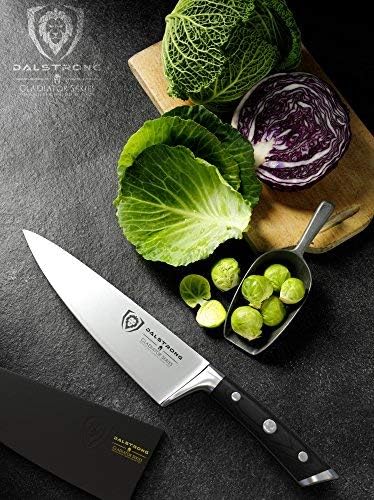 The Chef knife is the most important and basic knife for all kitchens. This is the knife that you can use for cutting and chopping vegetables along with preparing most kinds of meat.
The Chef knife is the most important and basic knife for all kitchens. This is the knife that you can use for cutting and chopping vegetables along with preparing most kinds of meat.
So, the Chef knife possesses a large blade that is finished smooth to perfection. This blade can crush things like garlic and olives and is often used for roughly smashing up condiments for extracting that raw flavor out in the dishes.
This knife is used for dicing and slicing almost any sort of food items. And as we have mentioned before, this is the most basic knife that anyone looking to learn the techniques of cutting should actually begin with.
Price-wise, a Chef knife can be pretty expensive with the ones from top brands going well beyond a $200 tag or even more. However, you could always get decent ones even under $100 which will work just as fine and make an economical purchase if you’re just starting out.
Santoku Knife
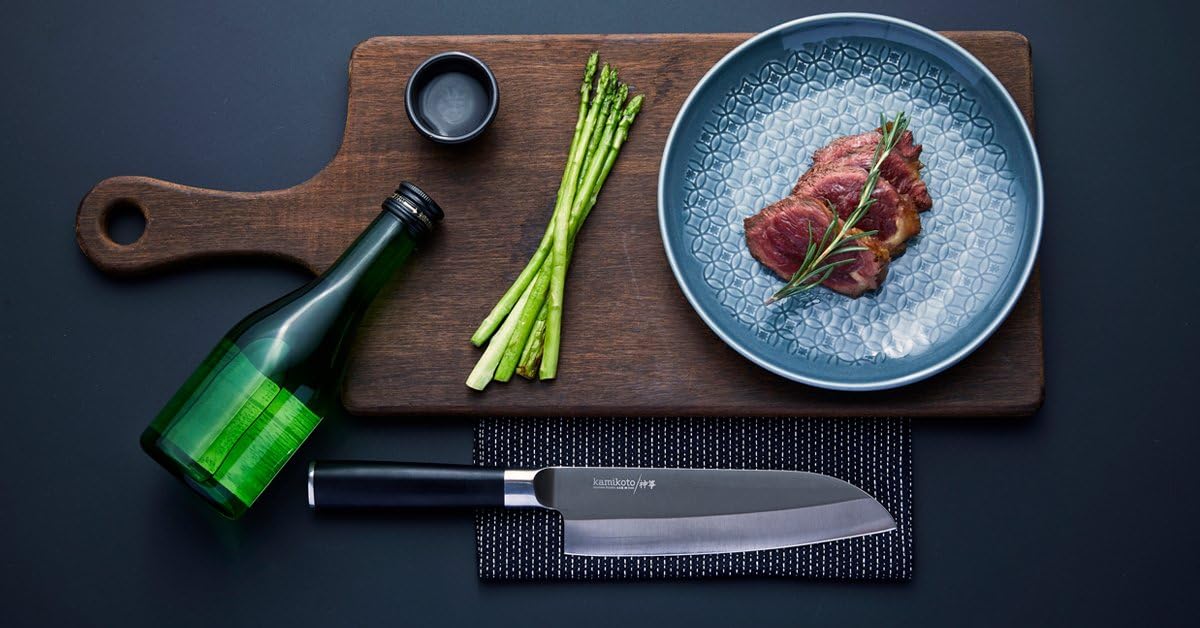 The Santoku is the traditional Japanese cutting knife which possesses a straight edge that isn’t really designed to be rocked in any way. The blade of the Santoku should be lifted off the board each time it is used to make a cut.
The Santoku is the traditional Japanese cutting knife which possesses a straight edge that isn’t really designed to be rocked in any way. The blade of the Santoku should be lifted off the board each time it is used to make a cut.
The fine edge of the Santoku is actually supported by a bigger and wider blade running right up to the tip. This is what enables the knife to deliver precise and straight cuts, as well as providing ultrafine slices, minces, and chops for everything.
A classic Santoku will measure about 7” and is usually treated as a prized possession by every chef around the globe.
The Santoku knife is the one that you should go for if you want a uniform and precise presentations. These help you achieve super-clean cuts for garnishes and plate decorations heightening the visual appeal of the dish.
Serrated Knife
The serrated knife is again one of the most essential kitchen knives ever. These knives have a long, thin blade with a serrated side. These are best suited for slicing all kinds of bread and fruits that may have a hard waxy exterior with a soft or pulpy inside.
A well-designed and rightly formed knife will slice smoothly right through these items without smooshing or tearing them apart which is a risk with softer veggies and fruits. This makes it perfect for cutting fruits and vegetables like tomatoes or eggplants.
You can even use it for slicing the rinds of pineapples, melons or hard-winter squash. Even baked goods such as pastries and cakes will require a serrated edge for that matter.
Although you might think that a simple Chef’s knife can do all of these, a serrated knife is way easier and safer to use. A serrated knife can be used cutting sandwiches and wraps as well without ruining the crumb or the edges. These provide clean cuts for delicate surfaces.
Even though a serrated knife can’t be honed with the regular sharpening steel, you can always get these re-sharpened by professionals. A decent serrated knife will cost you around $10-$30 in total.
Paring Knife
The paring knives are shorter than the standard Chef’s knife and can be used for quick cuts or trims. These are smaller than most other knives measuring around 2 to 4 inches and are generally used for finer cuttings such as for smaller vegetables like mushrooms, fruits or for mincing herbs. It is used for trimming fat off meat.
However, the smaller paring knives could be too short for you to hold it comfortably with an easy grip. For this, you could opt for longer utility knives that will provide you with all the benefits of a regular paring knife with the added advantage of a better grip.
Paring knives allow you to do several in-hand cutting, i.e. hand-held fruits or vegetable cutting such as making “fluting mushrooms”, “turning carrots” or peeling apples. For this purpose, we recommend a minimum of 3 inches for the paring blade.
A paring knife is perfect for fine detailing and delicate works. You can use both forged or stamped paring knives for all of these tasks. A decent paring knife could cost you anywhere between $30-$50.
Carving Knife
 A carving knife which is also known as a slicer or a carver has a long, thin blade with a very sharp and pointed tip. This is ideal for slicing large chunks of meat and cut them up into smaller, even pieces which are easier to serve and more palatable to consume.
A carving knife which is also known as a slicer or a carver has a long, thin blade with a very sharp and pointed tip. This is ideal for slicing large chunks of meat and cut them up into smaller, even pieces which are easier to serve and more palatable to consume.
A proper carving knife will have a flexible blade measuring about 20-26 cm. Longer blades could easily chop up wider joints in meat such as ham. The sharp, pointed tip of the knife helps separate meat from the bone. This makes it an ideal tool for making all kinds of roast be it chicken, ham, turkeys and etc.
However, it is always better to go for longer blades since they minimize the effort put in “sawing” or “shredding” the meat to cut it. And if you want to have paper-thin slices for your deli meat, then a smaller carver or a filleting knife would be pretty ideal for the purpose.
Boning Knife
A boning knife has a thin blade and is specially designed to scrape the meat right off the surface of the bone. This lets you maneuver around the joints to separate the meat from all parts easily. It cuts through ligaments, tendons and connective tissues. A boning knife could be used for making clean fish fillets, trimming fat and silverskin.
The popular and standard size for this knife is 5 inches. Also, the degree of flexibility will differ from one brand to another. But if you’re looking to chop up thick slabs or stumps then do get a stiffer blade, while for delicate cuts you could go for a more flexible one. These knives could cost anything between $10 to $100.
Filleting Knife
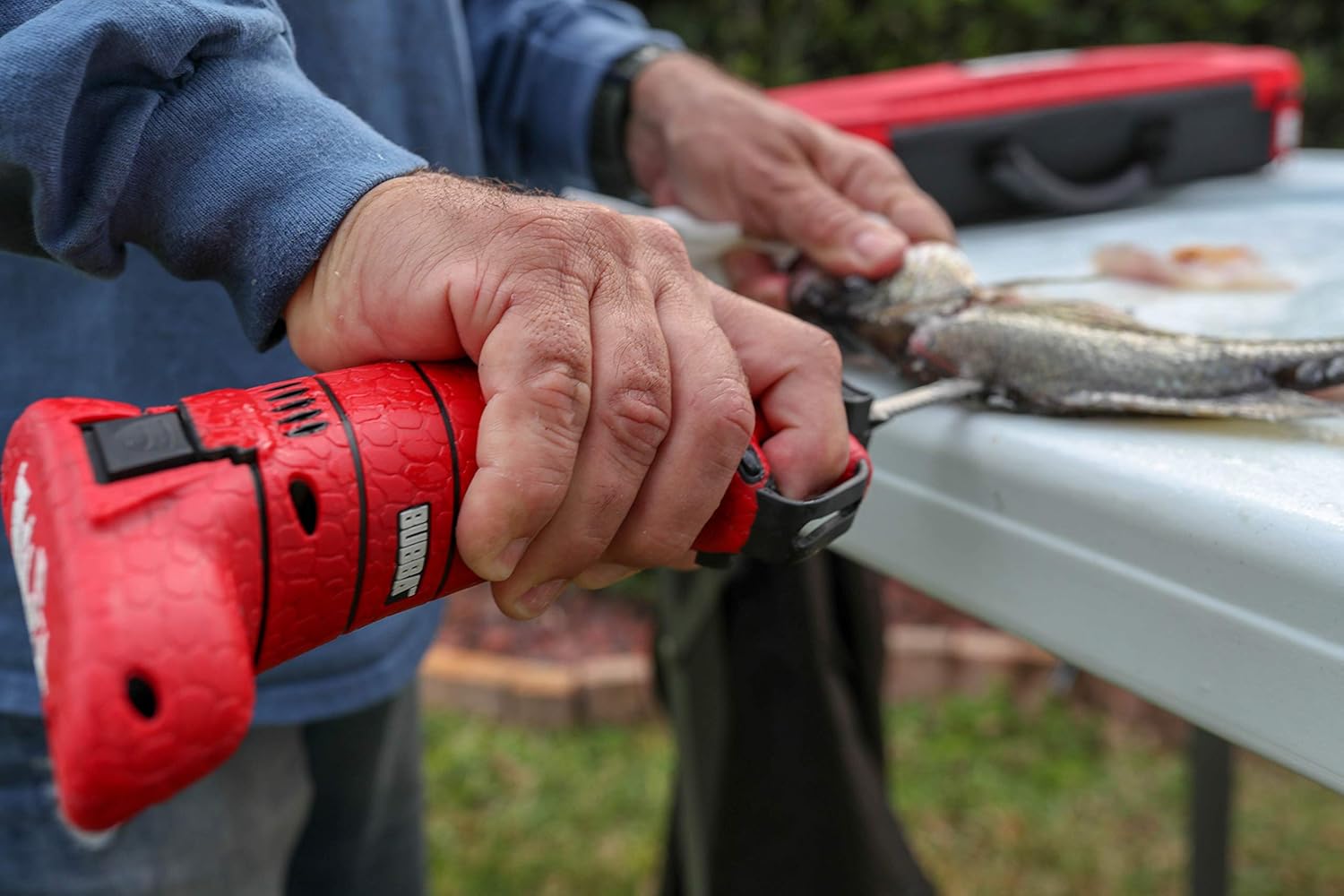 Filleting knife has a sharper, thinner, more flexible blade and acts like that of a boning knife. This is usually required for slicing or filleting a lot of fish. It is an ideal kitchen tool for removing the delicate blocks of flesh from a whole fish. But the greatest benefit that it provides is that it can pick the fine, pin bones from the fillets.
Filleting knife has a sharper, thinner, more flexible blade and acts like that of a boning knife. This is usually required for slicing or filleting a lot of fish. It is an ideal kitchen tool for removing the delicate blocks of flesh from a whole fish. But the greatest benefit that it provides is that it can pick the fine, pin bones from the fillets.
These have a pretty low drag that is suitable for skinning delicate fish and vegetables. The sizes of fillet knives could be between 4” to 10” and could cost you anywhere between $10-$100.
Construction
Primarily, there are two ways that knives are made:
Forging
Forged knives are created by applying extreme heat to a piece of steel. It is then molded into the desired shape. Forged knives are usually considered to be high-quality, being more expensive than stamped knives.
The process of forging creates a formidable blade that doesn’t bend or warp that easily. However, these knives require sharpening more often and may need to be replaced sooner than stamped knives.
Stamping
Stamped knives are machine-made. These are punched out of a metal piece. After this, the blade is defined by sharpening the edge, and the knife is made to be of the same thickness throughout.
Although these aren’t considered to be as good as forged knives, some of them really perform well, nevertheless.
Frequently Asked Questions
What is the “correct” weight for knives?
Always go for a knife that fits your hand size and provides you with a comfortable grip. It should be comfortable to use and provide you with the ease of maneuvering it at all times. However, there is no “correct” weight in this context, and this is mostly a personal preference.
What difference does the material of the knife handle make?
The material of a knife’s handle directly impacts the weight, balance, and ease of use that the product will allow. Even though you could go for a range of materials for knife such as wood, plastic, metal or composites, it’s always a good idea to experiment with these and determine what works for you best.
What benefits should the ideal knife provide?
A knife should simply make the tedious task of cutting up food easier, and not make it displeasure or a time-consuming task. The structure of the knife should be well-balanced to provide you with the ease of using it. The correct proportions on a kitchen knife go a long way in delivering the best results and maximum benefits regarding performance.
What kinds of blade materials could you go for?
Knives could be made of the following materials:
Carbon steel: This is a pretty strong material for knives, and these are harder than ordinary steel and are easier to sharpen. Yet, on the downside, these can be vulnerable to rusting and staining and generally more brittle than being flexible.
Damascus: This is a labor-intensive process that involves forging two different types of steel with heat, shaping the layers into recurrent folds. This is known as pattern welded or laminate steel that uses a soft-yet-tough steel layer with a harder/sharper steel layer.
Stainless steel: Stainless steel is always resistant to corrosion and makes high-quality, sharp-bladed and exceedingly formidable material for knives. Stainless steel knives are mostly manufactured by stamping.
High-carbon stainless steel: Knives made of high-carbon stainless steel provide a good balance of edge retention, sharpness, resistant to corrosion and easy resharpening facility.
Ceramic: Ceramic knives are pretty sharp. However, if you drop them, they’ll definitely shatter instantly. These are lighter than metal, but can’t be re-sharpened at home.
How to maintain and store knives properly?
Knives made with certain materials would corrode and rust faster than other materials. Most types of knives will require periodical re-sharpening. However, in any way, all kinds of knives should always be cleaned thoroughly after each use, preferably disinfected by heating and put away in a dry place or rack.
This will extend the shelf-life of the knives and keep them performing well for a substantial period of time.
Model | Number of Knives | Price | |
|---|---|---|---|
1 Chef's Knife | $ | ||
14 Pieces Cutlery Set | $$ | ||
15 Pieces Cutlery Set | $$ | ||
18 Pieces Cutlery Set | $$ |
Conclusion
So, this was our guide to kitchen knives for you. We hope that you liked and enjoyed what we put together and could now tell the difference between all sorts of these stab weapons!
You should also check out our reviews of various models:
- Best Henckels Knife Set 2023
- Best Wusthof Knife Set 2023
- Boning Knife Reviews 2023
- Bubba Electric Fillet Knife Reviews 2023
- Calphalon 15 Piece Knife Set Review 2023
- Chicago Cutlery Knives Review 2023
- Cuisinart Knife Set Reviews 2023
- Cutco Knives Reviews 2023 – The Finest Quality for The Finest Dining Experience
- Dalstrong Knives Review 2023
- Electric Knife Sharpener Reviews 2023
- Emeril Forged Knife Block Set Reviews 2023
- Global GF-35 Heavyweight Chef’s Knife Review
- Kamikoto Knife Reviews 2023 – Perfect Blend of Cutting Prowess and Aesthetic Beauty
- KitchenAid Knife Set Reviews 2023
- Kyocera KB5PCSET-FKWHRD Revolution Ceramic Knives Review
- Laguiole Set of 8 Steak Knives Forged Steel Blades Review
- Oneida Pro Series 14-Piece Side Tang Knife Block Set Review
- Shun Premier Chef’s Knife Review
- Victorinox Knife Set Review 2022


